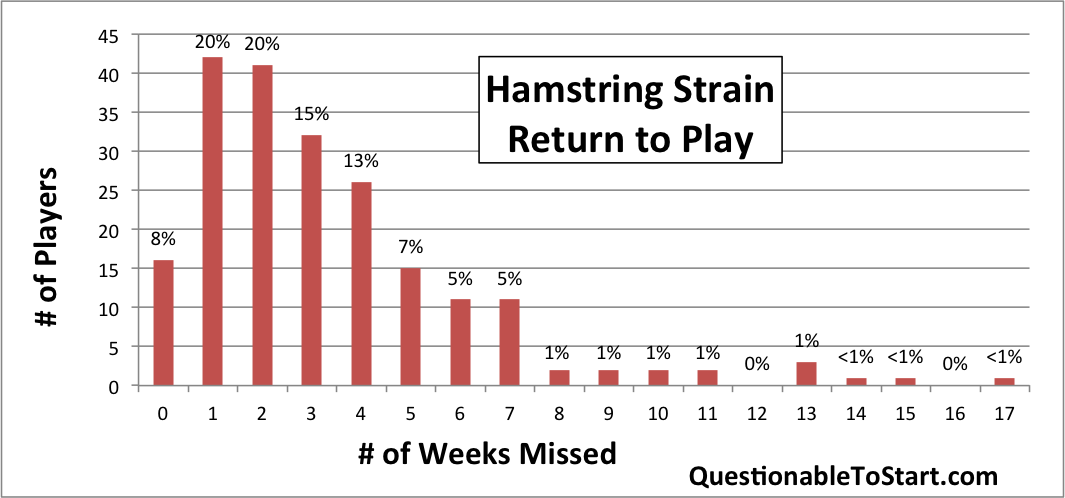As with all my sprain and strain injury estimates, make sure you read this general introduction first. But don’t zone out yet, there are actually some interesting NFL-specific things to talk about in regards to hamstring strains and tears.
If you didn’t bother following that link above, I’ll just point out that hamstring strains are when the hamstring muscle (the one that goes down the back of your leg) are overstretched and tear. On one end of the spectrum are small, minor tears that can be treated fairly simply. On the other end you have full muscle ruptures where the muscle is torn all the way through, and season-ending surgery is required. Also, if you didn’t read the link, I’ll take this chance to point out, yet again, that my database is currently missing a lot of players who miss zero time with hamstring strains. So take my RTP chart with a grain of salt, and maybe imagine a much higher column on the zero missed (far left hand side).
Enough already, let’s get to the interesting stuff. Or what passes for interesting when you’re neck-deep in the world of NFL injuries. Medscape has some great sports injury information if you’re willing to dig, and they gave me the next two nuggets. Quoting from Medscape here, “One study involving 47 football players with hamstring injuries reported an average of 14 days of convalescence before return to play.” I’m not sure that that’s an exact match with what I’m seeing in my RTP chart, but it’s in the same ballpark. Notice there’s some wiggle-room on this, as I count game missed, while the RTP talks of total days. Those two usually match up, but depending on the date of injury and the team’s schedule, that’s not always a given.
The hamstring strain facts that really stood out to be though were (again, from Medscape here): “One study analyzed data from the National Football League’s Injury Surveillance System and found that a high percentage of hamstring injuries occur in the preseason. Over the 10-year study period, 1716 hamstring strains were noted, with slightly more than 50% occurring during the preseason. Players on the special teams units as well as wide receivers and defensive secondary were found to have an elevated risk for injury.”
So we’re looking at an injury that is more likely to affect wide receivers, defensive backs, and and special teamers. Why is that? Ask yourself what those players have in common. Yes, they all rely on speed. But, more specific to the hamstrings, they all also rely on changes of direction and stops, which put a heavy burden on the hamstring muscle. Hamstrings play a role in a lot of leg movements, but they’re the primary muscle involved in, “putting on the brakes.” As for the timing, it’s speculated that preseason is the harshest time for hamstring strains (and other muscle strains) because the players are not yet in peak physical shape. The preseason is often a time where players are pushing themselves as hard as they can in order to get back into shape or to make a team roster. That spells trouble for overworked muscles.
One last thing I’d like to point out is that hamstring strains, even more than other sprains and strains, seem to have a high incidence of recurrence. From my (biased) perspective, it seems that players and teams that try to rush back often experience later re-injuries and setbacks of the same hamstring muscle. This seems to be a widely accepted fact in the sports medicine world, and is noted in that Medscape hamstring profile. In my database, I show that roughly 18% of the players who suffer hamstring strains end up re-injuring the same hamstring during the same season. There are some biases with that, but it’s interesting nonetheless. Because of this high risk of re-injury, I would caution that, even when a player has rehabbed and returned from a hamstring strain, he might end up back where he started, nursing the same injury. It seems like you’re never really done with a hamstring strain until the hamstring strain is done with you. So wise.


